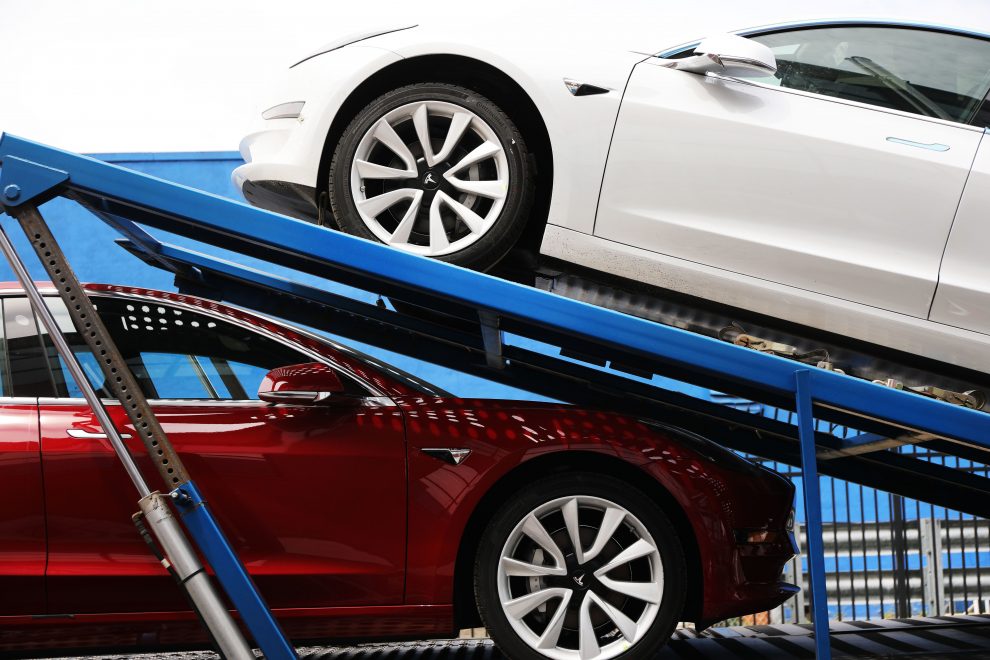
Tesla plunged 10% in extended trading after posting a larger-than-expected loss on Wednesday in a second quarter earnings update.
Here’s what Tesla reported, versus what analysts expected based on average estimates compiled by Refinitiv:
- Loss per share on an adjusted basis: $1.12 vs. 40 cents expected
- Revenue: $6.35 billion versus $6.41 billion expected
That compares with an adjusted loss of $3.06 per share on $4 billion in revenue during the same period last year.
Although the electric car company fell short of analysts’ expectations, it reaffirmed full-year delivery guidance, saying it still expects to sell 360,000 to 400,000 vehicles this year, mostly Model 3s.
Tesla delivered around 158,200 of its cars to customers in the first six months of 2019. It has to deliver more than 200,000 in the back half of the year to hit the low-end of its guidance. The company says it has a weekly run-rate of 7,000 Model 3 vehicles, and aims to be able to produce 10,000 Model 3s weekly by the end of 2019.
To make high-volume sales of the Model 3 possible, Tesla said in its second-quarter letter, it plans to improve production at its existing factories including its battery plant outside of Reno, Nevada and a car assembly in Fremont, California.
Tesla is aiming for a start of production of the Model 3 in China by the end of the year, which will allow it to benefit from lower costs to deliver to customers there, while reaping the rewards of local regulatory credits.
The company recently achieved a record in terms of vehicle production and deliveries, selling 95,200 vehicles during the second quarter and producing 87,048 cars during that period, it said earlier this month.
That led to automotive revenue for Tesla of $5.38 billion during the second quarter, with $111.2 million from regulatory credits of every type.
The company blamed a decline in the average sales price of its vehicles during the second quarter on the roll out of its Model 3 Standard Range Plus, and sales of inventory Model S and Model X vehicles that lacked an upgraded powertrain, which gives the cars the ability to drive further on a single charge.
However, Tesla reported that the average sale price of its Model 3s in North America remained at $50,000, the same level as in late April, when the company delivered its first-quarter results.
While sales of Tesla’s energy storage products — the Powerwall and Powerpack — increased during the second quarter, sales of its solar energy products declined. Tesla combines these into a single line item, and said they generated $368.2 million in revenue from energy generation and storage products in the second quarter, a 2% decline over the same period last year.
Tesla cars are delivered to a showroom in Brooklyn on April 25, 2019 in New York City.
Spencer Platt | Getty Images
Tesla’s Powerwalls are now installed at more than 50,000 sites, the company revealed. These are its home energy storage batteries, meant to drive the adoption of renewable energy at home.
The company is trying to do more with less, revising its capex guidance down to $1.5 billion to $2 billion. It previously expected 2019 capital expenditures to reach $2 billion to $2.5 billion. That money goes toward development of the company’s “main projects,” including the completion of its Gigafactory in Shanghai, Model Y SUV and Tesla Semi, as well as expansion of Tesla’s Supercharger and service networks.
On a bright note for Tesla, the company is more liquid than ever, following a nearly $3 billion capital infusion in May. Its cash position increased to $5.0 billion, with $2.4 billion in net proceeds from its equity and convertible debt offerings in May, and $614 million of free cash flow.
Tesla shares had closed higher on Tuesday at $260.17, and risen in trading on Wednesday before the earnings update. But shares had declined 22% this year as of markets close Tuesday.
In their first quarter update, Tesla executives braced investors for another loss in the second quarter. But Tesla said Wednesday it still expects return to profitability in the third quarter.
Follow @CNBCtech on Twitter for the latest tech industry news.








